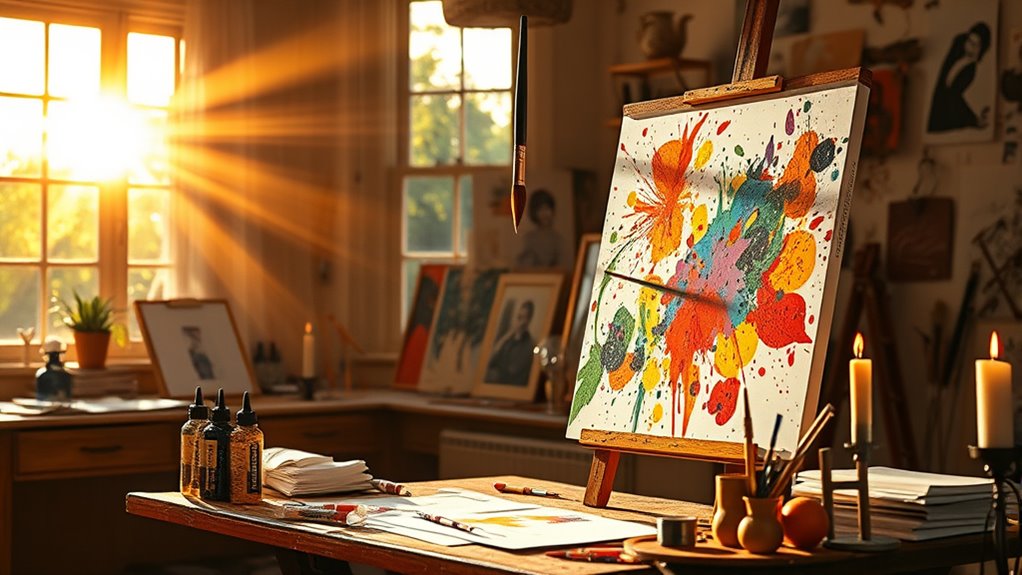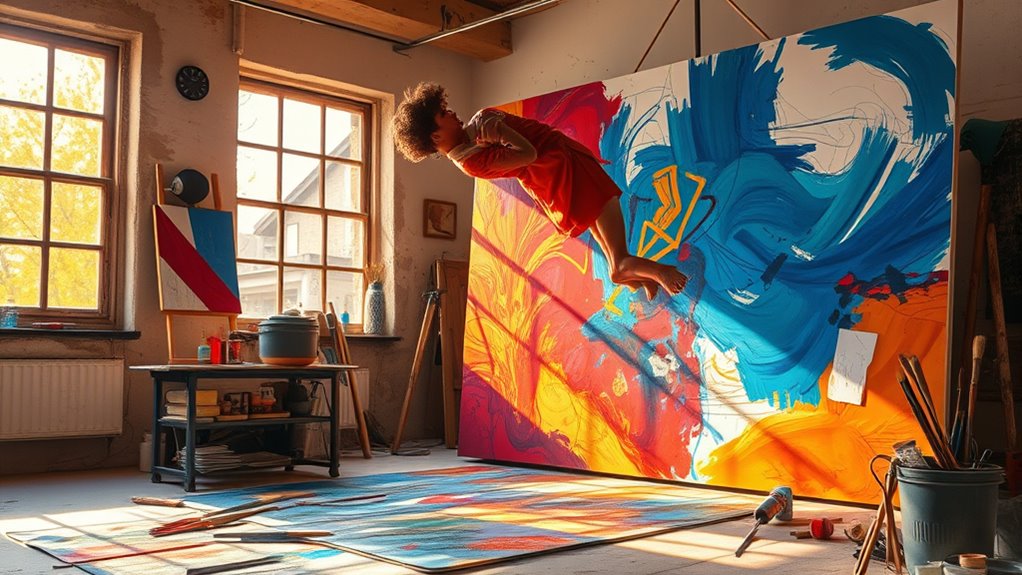To tap into your creative flow and access intuition, focus on cultivating an immersive environment free of distractions. Practice mindfulness techniques like breath awareness, body scans, or sensory observation to clear mental clutter and connect deeply with your inner voice. By setting clear goals, creating routine, and engaging in spontaneous activities like free drawing, you can enhance spontaneity and effortless creation. Explore how these approaches can release your authentic artistic impulses as you continue exploring.
Key Takeaways
- Artists access creative flow by practicing mindfulness techniques like breath awareness and body scans to quiet mental chatter and enhance presence.
- Tapping into intuition involves decluttering the mind and listening to internal impulses during spontaneous, uninhibited artistic expression.
- Setting clear goals and establishing dedicated, interruption-free environments help sustain the focused state needed for flow.
- Engaging in sensory awareness exercises sharpens perception, allowing artists to respond authentically to subtle details and inspiration.
- Collaborative projects and improvisation foster connection and spontaneity, deepening trust in intuitive decision-making during the creative process.
Understanding the Concept of Creative Flow

Creative flow is a mental state where you feel fully immersed and energized by your activity, often losing track of time and self-consciousness. During this state, you might engage in collaborative improvisation, seamlessly adapting ideas with others, or focus intensely on visual storytelling. You’re not just creating; you’re experiencing a deep connection with your work, where every brushstroke or word feels instinctive. This heightened engagement allows ideas to flow effortlessly, making your art feel natural and spontaneous. In creative flow, barriers dissolve, and your skills align with your inspiration. It’s the zone where your talents come alive, and your work takes on a life of its own. Recognizing the importance of sound design techniques can also amplify your creative process by immersing your audience more deeply. Cultivating an environment conducive to creative practices can help you enter this state more consistently, enhancing your overall artistic output.
The Role of Intuition in Artistic Expression

Intuition often acts as a guiding force in artistic expression, allowing you to make spontaneous decisions that feel inherently right. When you trust your gut, you engage in intuitive decision making, which helps you move beyond conscious analysis and tap into subconscious inspiration. This process enables you to respond authentically to your creative impulses without overthinking. Your intuition acts as a bridge between your inner feelings and your artistic choices, leading to more genuine work. As you become more attuned to these subtle signals, you’ll notice how your instincts shape your style and direction. Embracing intuition fosters a sense of freedom and encourages you to explore new ideas without hesitation, ultimately enhancing your artistic expression. Additionally, mindful decluttering can help clear mental space, making it easier to access your intuitive insights and stay focused on your creative flow.
Signs That Indicate You’re in a Flow State

When you’re truly immersed in your work, certain signs can reveal that you’re experiencing a flow state. You might notice your creative instincts taking over, making decisions effortlessly. Time seems to slip away, and you feel fully engaged, with little awareness of distractions. Your artistic intuition guides your hand smoothly, leading to a sense of mastery. You may also experience a heightened focus and a sense of enjoyment in the process. Recognizing these signs helps confirm you’re in flow. Here’s a quick overview:
| Sign | Feeling | Effect |
|---|---|---|
| Loss of self-consciousness | You’re unaware of judgment or external criticism | Deep immersion |
| Time distortion | Hours feel like minutes | Enhanced focus |
| Effortless creation | Actions feel natural, not forced | Artistic intuition flows |
| Full engagement | You lose track of surroundings | Creative instincts dominate |
Additionally, understanding the importance of mental state can help artists intentionally cultivate flow experiences. Developing a positive environment can further facilitate entering flow states, making the creative process more seamless.
Techniques to Enter and Sustain Flow

Achieving and maintaining a flow state requires intentional strategies that help you stay fully immersed in your work. One effective technique is engaging in collaborative projects, which foster a sense of connection and accountability, keeping your focus sharp. Using digital tools can streamline your process, eliminate distractions, and provide structure—think project management apps or creative platforms that organize ideas seamlessly. Setting clear goals before starting helps you stay on track, while creating a dedicated workspace minimizes interruptions. Regularly taking short breaks recharges your energy, preventing burnout. Embrace routines that signal the start of focused work, and stay flexible enough to adapt as your creative needs evolve. Recognizing your family dynamics and heritage can also inspire deeper artistic insight and authenticity. Incorporating sound healing science techniques, such as listening to specific frequencies, can further enhance your concentration and emotional balance, helping you access your full artistic potential. These techniques help you enter and sustain flow, access your full artistic potential.
Overcoming Distractions and Creative Blocks

Distractions and creative blocks can abruptly pull you out of your flow, but recognizing common triggers allows you to address them proactively. Practice mindfulness techniques to stay present and aware of when your focus drifts. Regular mindfulness practices, like deep breathing or brief meditation, help you reset and regain clarity. Effective time management is essential; set specific periods dedicated solely to your creative work, minimizing interruptions. Break large projects into manageable steps to reduce overwhelm and prevent creative stagnation. Avoid multitasking, which can fragment your attention. When you notice a block, pause, breathe, and gently refocus on your goals. Understanding narcissistic traits can help you recognize when external influences may be affecting your focus or emotional state. Additionally, staying informed about AI job trends can inspire new ideas and approaches in your creative process. By implementing these strategies, you’ll maintain momentum and navigate around distractions more smoothly, keeping your creative energy flowing freely.
Creating the Ideal Environment for Inspiration

Creating an environment that sparks inspiration begins with intentionally arranging your space to foster creativity. Use ambient lighting to set a calming, inviting mood that encourages focus and reflection. Soft, warm lights can help reduce eye strain and create a cozy atmosphere, making it easier to enter a flow state. Incorporate inspiring decor—artwork, meaningful objects, or vibrant colors—that energizes your mind and sparks new ideas. Keep your workspace organized to minimize distractions and maintain clarity. Personal touches, like plants or photographs, make the space uniquely yours, enhancing comfort and motivation. Additionally, understanding color accuracy can help you select decor and lighting that optimize visual harmony and stimulate your creative instincts. Being aware of regional resources available for inspiration can also provide new perspectives and ideas to incorporate into your work. By thoughtfully designing your environment, you create a sanctuary where creativity flows freely, and intuition can thrive. This setting becomes a catalyst for your artistic expression and innovative thinking.
The Impact of Mindfulness and Meditation on Creativity

Mindfulness and meditation can considerably boost your creative potential by helping you stay present and focused. These practices enhance mindfulness benefits, such as reducing stress, increasing awareness, and fostering mental clarity. Meditation techniques like deep breathing, body scans, and guided imagery help quiet mental chatter, opening space for fresh ideas. This focused state allows you to access intuition more easily and connect with your inner creative voice. Incorporating simple, joyful experiences into your relaxation routines can also provide a playful and inspiring break, sparking new ideas through these accessible and evidence-based practices.
Practical Exercises to Cultivate Your Creative Flow

To boost your creative flow, try incorporating mindfulness meditation techniques that help clear your mind and boost focus. Engaging in free drawing sessions encourages spontaneous ideas and open your creative potential. Additionally, practicing sensory awareness exercises can heighten your perception and inspire fresh perspectives. Exploring different artistic tools and painting techniques can also stimulate your creativity and help you discover new styles. Developing a methodical approach to your art can further enhance your ability to maintain a steady, inspired workflow.
Mindfulness Meditation Techniques
Practicing mindfulness meditation can considerably enhance your ability to enter and sustain creative flow states. One effective technique is focusing on breath awareness, where you observe your breath without judgment. This anchors your attention and calms the mind. Another method is a body scan, systematically bringing awareness to each part of your body, releasing tension and fostering presence. Regularly practicing these exercises sharpens your focus and cultivates a receptive mental state for creativity. Additionally, monitoring expiration dates on your creative projects or tools can help maintain a fresh perspective and prevent stagnation. Incorporating mindful observation of your surroundings allows you to notice subtle details that can inspire new ideas. Below is a simple table to guide your practice:
| Technique | Focus Area | Duration |
|---|---|---|
| Breath Awareness | Breathing | 5 minutes |
| Body Scan | Whole body | 10 minutes |
| Focused Attention | Specific object | 3 minutes |
| Mindful Observation | Surroundings | 2 minutes |
Incorporate these into your routine to access deeper creative flow.
Free Drawing Sessions
Engaging in free drawing sessions allows you to translate your mindful awareness into spontaneous creativity. These sessions encourage you to let go of perfection and embrace organic expression, fostering your intuitive skills. To deepen your practice, consider these exercises:
- Practice collaborative improvisation by drawing with a partner, building on each other’s spontaneous marks.
- Create visual storytelling pieces without planning, allowing your imagination to guide the narrative.
- Set a timer and draw continuously, focusing on flow rather than accuracy.
- Use unexpected tools or materials to challenge your creativity and break habitual patterns.
- Remember that attention plays a crucial role in enhancing your creative practice, helping you stay present and fully engaged in each session. Additionally, understanding beauty hours can help you plan creative activities during optimal times for focus and inspiration.
These approaches help you access the subconscious, enhance improvisation skills, and develop a natural flow that supports your artistic intuition.
Sensory Awareness Practices
Enhancing your creative flow begins with sharpening your sensory awareness, allowing you to fully experience each moment and draw inspiration from it. Awareness training helps you tune into subtle sensory cues—textures, sounds, smells—that often go unnoticed. Practice exercises like mindful observation or sensory walks to heighten sensitivity. Recognize that heightened awareness opens new creative pathways. Use this table to understand sensory cue focus:
| Sensory Cue | Example Exercise |
|---|---|
| Visual | Observe details in your surroundings |
| Auditory | Listen intently to ambient sounds |
| Tactile | Feel textures during daily activities |
| Olfactory | Notice scents in your environment |
Engaging with your environment by inspecting components like bike tires can also sharpen your awareness of subtle details, fostering a more attentive and inspired mindset.
Frequently Asked Questions
How Do Different Art Forms Influence Flow Experiences?
Different art forms influence your flow experiences through medium-specific techniques and sensory engagement. As you work in painting, you might focus on brushstrokes and color blending to deepen immersion. In music, rhythm and sound textures boost your sensory connection. Each discipline demands unique skills that keep you fully present, heightening your flow. By embracing these techniques, you tap into intuition and sustain a state of creative momentum across various art forms.
Can Flow States Improve Long-Term Artistic Skills?
Research shows that artists practicing mindfulness improve their skills faster, highlighting how flow states can boost long-term skill development. When you enter a flow state, you’re fully immersed, which helps refine techniques and foster creativity. Regularly engaging in mindfulness practices enhances your ability to access these states, leading to sustained growth and mastery. So, yes, flow states can markedly improve your long-term artistic skills through focused, mindful engagement.
What Role Does Emotional Vulnerability Play in Creativity?
Emotional vulnerability plays a vital role in creativity by allowing you to embrace emotional openness. When you’re vulnerable, you tap into deeper feelings, which fuels authentic expression and originality. Vulnerability benefits your art by fostering genuine connections with your audience and enabling you to explore complex themes. By being open about your emotions, you create more compelling, relatable work that resonates on a profound level, ultimately enriching your creative process.
How Does Physical Movement Enhance Artistic Intuition?
Imagine your mind-body connection as a flowing river, where movement meditation acts as the current guiding your intuition. When you move intentionally, you clear mental blocks and deepen your awareness, revealing creative insights. Physical movement enhances artistic intuition by syncing your body and mind, allowing inspiration to surface effortlessly. Embrace movement as a tool to access your inner creative reservoir, transforming instinct into expressive artistry.
Are There Cultural Differences in Experiencing Creative Flow?
You might notice that cultural perceptions influence how you experience creative flow, with some cultures emphasizing collective expression and others valuing individual innovation. Traditional practices often shape your approach, guiding when and how you enter flow states. These cultural differences can affect your openness to spontaneity and intuition, ultimately enriching or challenging your creative process. Embracing diverse cultural influences can deepen your connection to your art and enhance your flow experiences.
Conclusion
When you tap into your creative flow, you *unlock* deep intuition that fuels your art. Studies show that artists in flow experience up to 500% more productivity and satisfaction. By embracing techniques like mindfulness and creating inspiring environments, you can sustain that state more often. So, keep experimenting and stay open—you’ll discover that your most innovative ideas emerge when you trust your instincts and let your creativity *flow* freely.









